Are you ready to explore the world of investment opportunities? In this article, we'll dive into the essentials of crafting a compelling securities offering memorandum, a vital tool for attracting potential investors. We'll break down the key components, including risk factors, management discussions, and financial projections, ensuring your memorandum stands out from the crowd. Join us as we uncover the intricacies of this important document and help you create an effective pitch that resonates with investors. Keep reading to discover more!

Legal Compliance and Regulatory Framework
Legal compliance in securities offering memorandums encompasses a range of regulations and protocols necessary for ensuring transparency and protecting investor interests. The Securities and Exchange Commission (SEC), established under the Securities Act of 1933, mandates that all offerings include detailed disclosures regarding the investment's risks, financial state, and the use of proceeds, ensuring investors have access to crucial information. Relevant state regulations, often referred to as Blue Sky Laws, require compliance for offerings to prevent fraudulent practices at the state level. Furthermore, adherence to the regulations under Regulation D, particularly Rule 506(b) and 506(c), allows for exemptions from registration requirements under specific conditions. Mandatory disclosures include but are not limited to management backgrounds, financial statements (typically audited), and any litigation risks associated with the issuing entity. Failure to comply can result in severe penalties, including fines or rescission rights that permit investors to reclaim their investments, underlining the importance of a robust legal framework in securities offerings.
Risk Factors and Investment Risk Disclosure
Investment in securities involves significant risk factors that potential investors should carefully consider before making any financial commitment. Market volatility may lead to fluctuations in share prices, affecting overall investment returns. Regulatory changes, influenced by national laws (such as the Securities Exchange Act of 1934 in the United States), may impose compliance costs that hinder profitability. The issuer's financial instability increases the possibility of loss, with bankruptcy risks associated with entities holding substantial debt. External factors like economic recessions can exacerbate these risks, impacting sectors (e.g., technology, real estate) unevenly. Investors must also consider the liquidity risk; certain securities might not be easily tradable, resulting in difficulties in buying or selling at desired prices. Finally, management decisions and business strategies (including mergers and acquisitions) play crucial roles in an issuer's performance, making it vital for investors to perform thorough due diligence.
Financial Projections and Business Model Clarity
Financial projections and business model clarity are essential components of an effective securities offering memorandum, particularly for startups and companies seeking investment. The projections typically cover a five-year timeframe, incorporating key financial metrics such as revenue, net profit margin, and operating expenses. For instance, a tech startup might project revenue growth from $500,000 in Year 1 to $5 million by Year 5, reflecting an aggressive growth strategy fueled by market expansion and product innovation. The business model must clearly outline the value proposition--how the company will generate revenue, such as through subscription services or direct sales. Market analysis should also highlight target demographics, projected market size, and competitive landscape, providing insights on customer acquisition strategies and retention rates. Clarity in these details enhances investor confidence, demonstrating a well-structured approach to achieving financial success.
Management Team and Organizational Structure
The management team of XYZ Corporation, a dynamic player in the renewable energy sector, is composed of seasoned professionals with extensive experience in finance, operations, and industry-specific knowledge. The Chief Executive Officer, Jane Doe, brings over 15 years of leadership experience from her tenure at Fortune 500 companies, overseeing strategic planning and execution. The Chief Financial Officer, John Smith, possesses a robust background in investment banking, specializing in raising capital and managing investor relations, having facilitated over $500 million in equity offerings. The Director of Operations, Emily Johnson, a mechanical engineer by training, has successfully led large-scale projects in solar energy, integrating advanced technology and sustainable practices. XYZ Corporation's organizational structure is built on hierarchical models that emphasize collaboration and innovation, ensuring clear communication and accountability across divisions, including R&D, production, and sales, all strategically aligned to enhance operational efficiency and market competitiveness.
Use of Proceeds and Investment Strategy
The use of proceeds from the securities offering will be strategically allocated to enhance operational capabilities and drive growth initiatives in targeted sectors, including technology and renewable energy. A significant portion, approximately 50%, will be directed towards research and development (R&D) efforts, particularly focusing on innovative solutions in artificial intelligence and sustainable practices. Investment in advanced manufacturing facilities is also a priority, with a budget allocation of around 30%, aimed at increasing production capacity and efficiency in response to market demand. Furthermore, approximately 20% of the proceeds will be reserved for strategic acquisitions of complementary businesses, particularly within the North American and European markets, enhancing value through diversification and market expansion. The investment strategy emphasizes long-term value creation, while maintaining a balanced risk profile through diversified asset allocation and adherence to regulatory compliance.
Letter Template For Securities Offering Memorandum Samples
Letter template of Securities Offering Memorandum for Accredited Investors
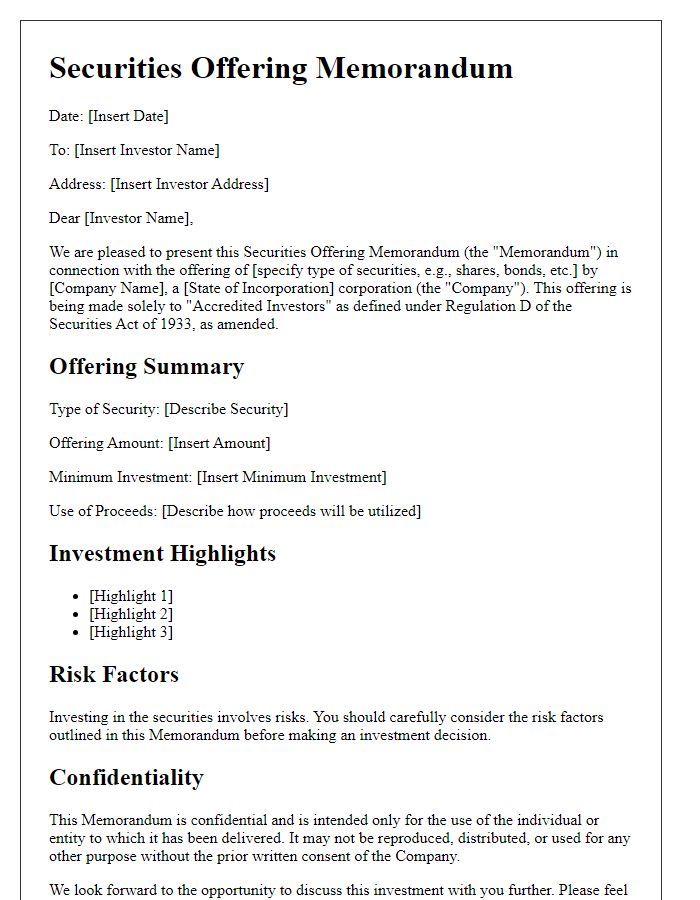
Letter template of Securities Offering Memorandum for Real Estate Investment

Letter template of Securities Offering Memorandum for Private Equity Fund
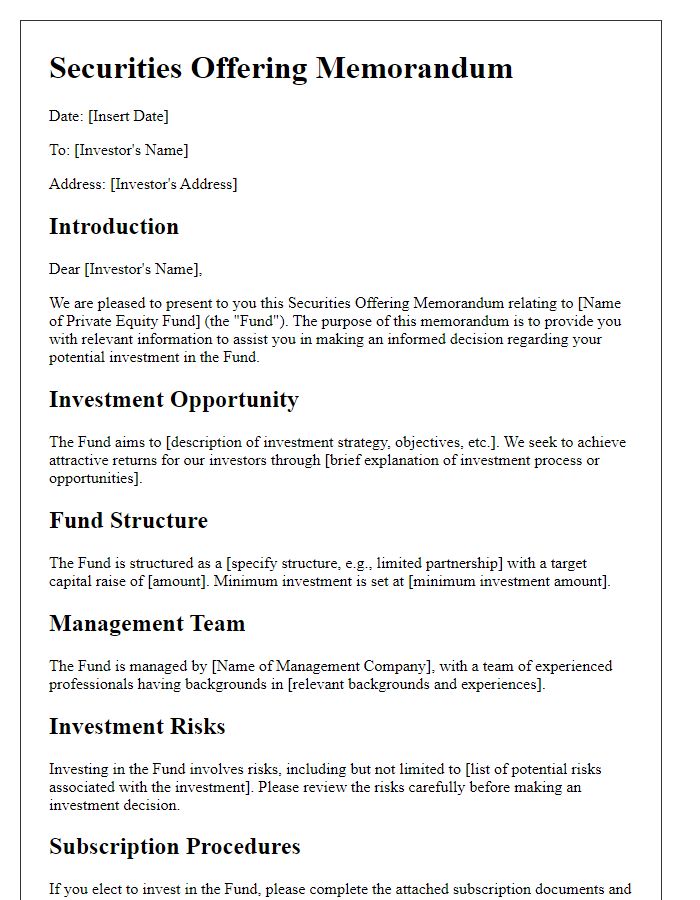
Letter template of Securities Offering Memorandum for Start-Up Financing
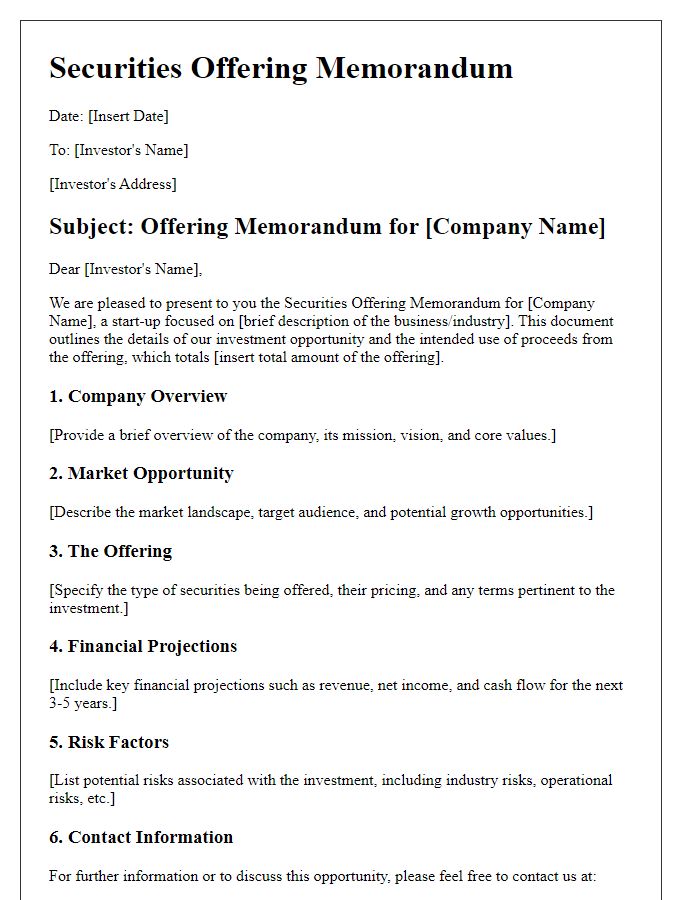
Letter template of Securities Offering Memorandum for Equity Crowdfunding
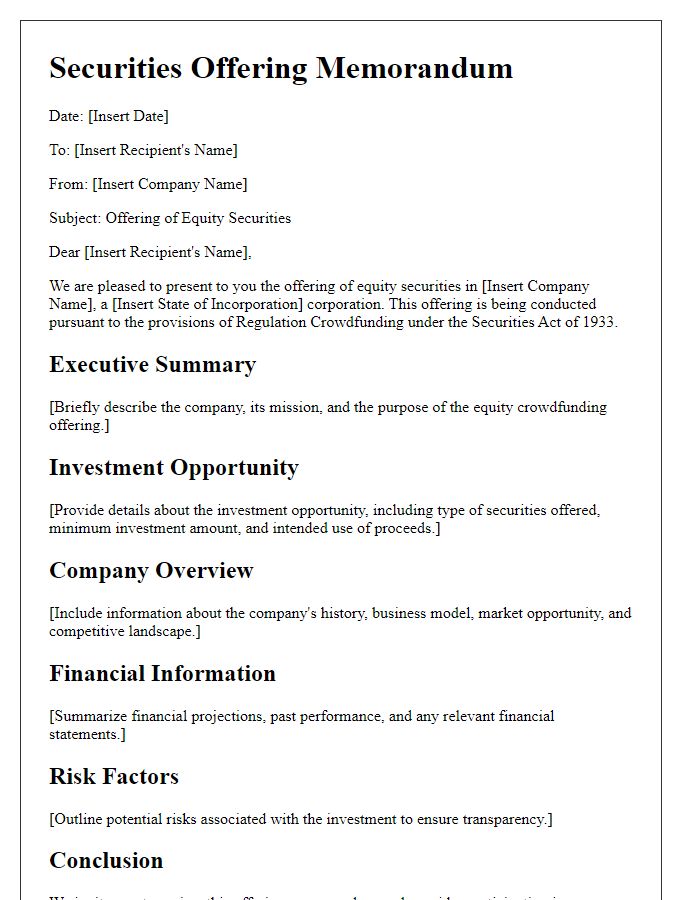
Letter template of Securities Offering Memorandum for Institutional Investors


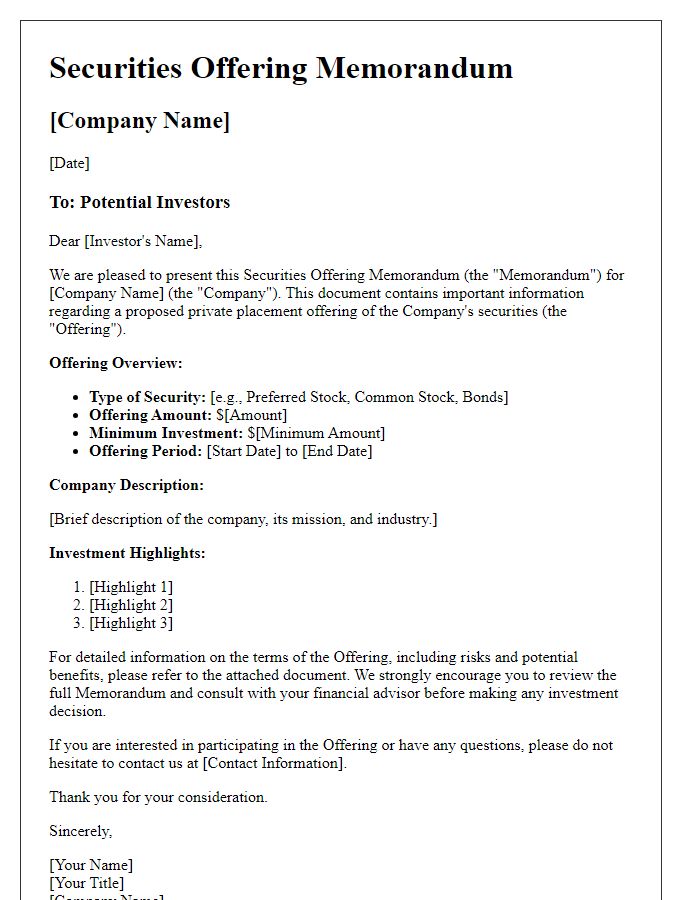
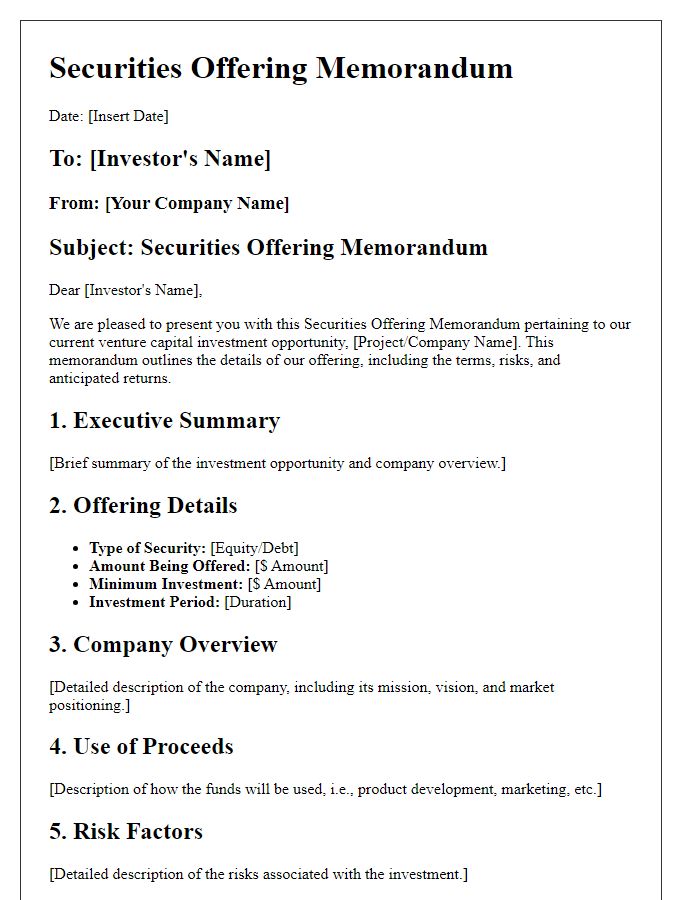
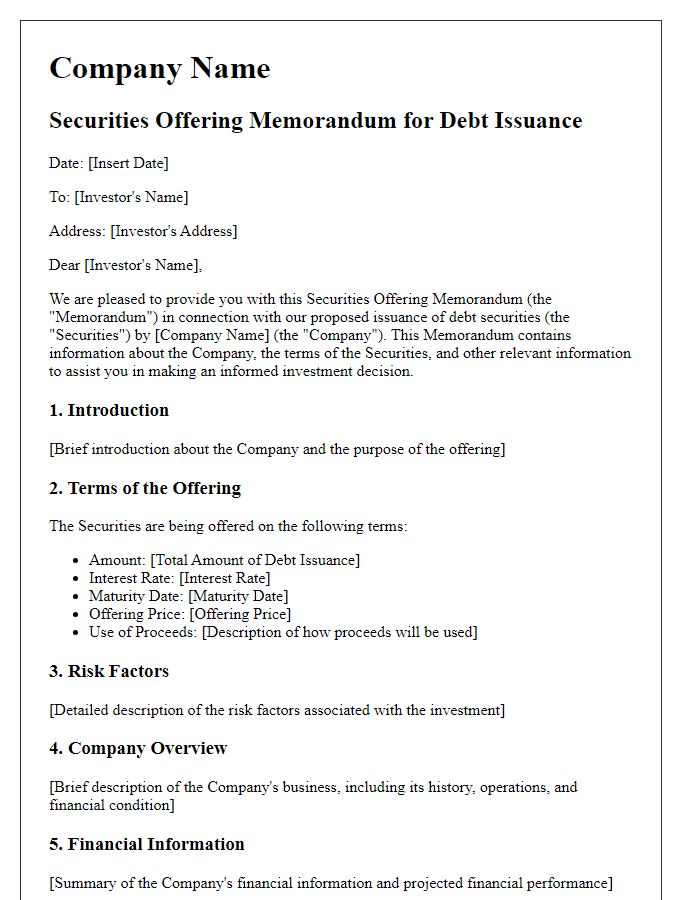
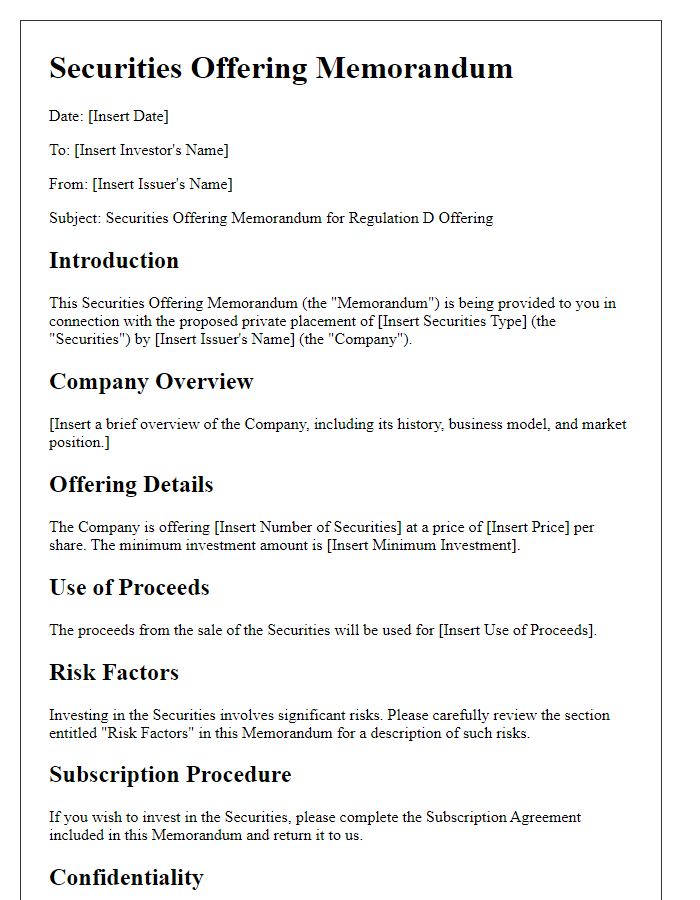


Comments